Comet lander: Future of Philae probe 'uncertain'
- Published
- comments
The European Space Agency told an online news briefing the drill has been active
The Philae lander has attempted to drill into the surface of Comet 67P, amid fears that its battery may die within hours.
The European Space Agency (Esa) says the instrument is being deployed to its maximum extent, despite the risk of toppling the lander.
Scientists hope the tool will be able to capture some samples for analysis in the robot's onboard laboratories.
If the battery dies, the results may not make it back to Earth.
Philae made history on Wednesday when it was dropped by Esa's Rosetta satellite to the surface of 67P - the first time this feat has been achieved.
The probe has been returning pictures and other scientific data ever since.
Key objective
It is not known precisely where on the comet the robot is located, but the pictures it has returned indicate it is in the shadow of a cliff.
The limited sunlight the probe receives means its solar panels cannot keep the battery systems properly topped up.
Engineers doubt Philae in its current position can stay powered beyond Saturday.
The dwindling energy reserves have therefore prompted the mission team to deploy the drill now.
Although the activity is among Philae's key objectives, it is also highly risky, because the torque on the tool could destabilise the delicately placed lander.
But Esa believes that the closing power window makes that risk worthwhile.
Power possibilities
Commands were uploaded on Friday morning to deploy the drill, and early telemetry indicated it had extended 25cm from the base of the lander.
However, it was then that the orbiting Rosetta satellite, which has been relaying telecommunications from the probe, passed over the horizon and out of contact.
The results of the drilling will not now be known until Rosetta comes back around and tries to re-establish the radio on Friday night.
Stephan Ulamec, the Philae lander manager, said: "The drill has been active today. Whether it will sample and will succeed in bringing these samples to [laboratory] ovens - we shall know this evening.
"This would be fantastic but it is not secured - maybe the battery will be empty before we get contact again."
Engineers are working on potential solutions to boost the power available to the lander.
"We plan to rotate the lander a little bit so that at the position where we have now this one panel that gets sun, we'll have a slightly larger panel and this would increase the chance that at a later stage the lander could wake up again and start talking to us again," Dr Ulamec explained.

One remarkable image taken by the "mothership" Rosetta shows Philae as a tiny speck, headed for history
More extreme ideas are also being considered.
One involves firing up Philae's flywheel - a mechanism that was used to keep it stable during its descent to the comet on Wednesday.
Another would shift the legged landing system in such a way that a small amount of upwards momentum could be generated.
Because Comet 67P is only 4km wide, it has very little gravitational attraction, and so even small motions could be enough to bump the probe out of its dark spot.
"It's very unlikely; we're just throwing around ideas right now," conceded Valentina Lommatsch from the German Space Agency.
And for such a strategy to work, Friday night's radio connection would be needed to upload the necessary commands.
"Hopefully, we'll get the link; that's the most important thing. What happens after that... is cream on the top right now," lander team-member Lommatsch added.
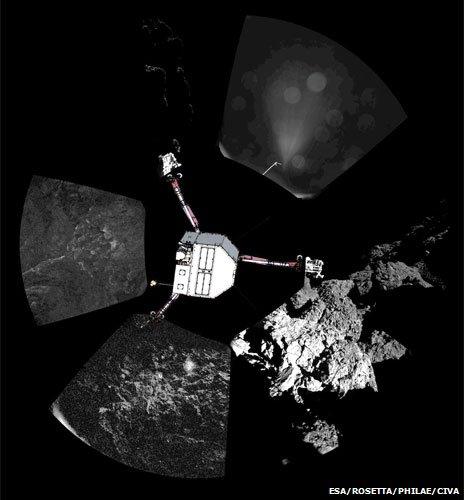
Several images have been taken on different sides of the lander, illustrated here with the pictures arrayed around a diagram of the probe
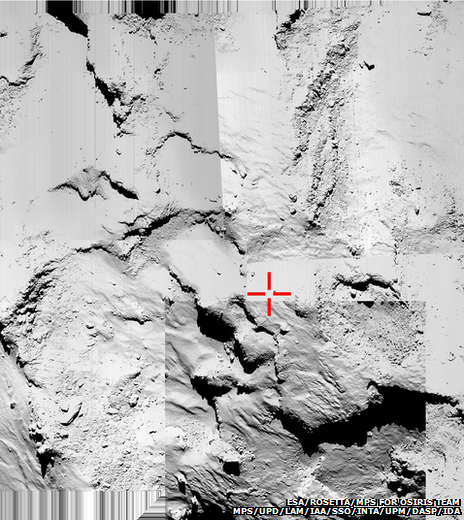
Where did Philae actually touch down? Images from the Osiris camera on Rosetta show the area surrounding the original target site (red cross)
Meanwhile, the hunt for Philae's exact location goes on.
Scientists have been examining radio transmissions between the orbiter and the lander to see if they can triangulate a position.
This work has now produced a "circle of uncertainty" within which Philae almost certainly lies.
The Osiris camera team on Rosetta is also looking through its latest high-resolution images for any sign.
One intriguing prospect is that Osiris may have caught Philae in the act of bouncing during Wednesday's landing. The probe is known to have rebounded several hundred metres back up from the surface at the moment of first contact - before then falling back down.
"We know that at about 500m above the ground, we should see the rebound and the rebound direction, which should give valuable information for the search team," Osiris team leader Holger Sierks said.
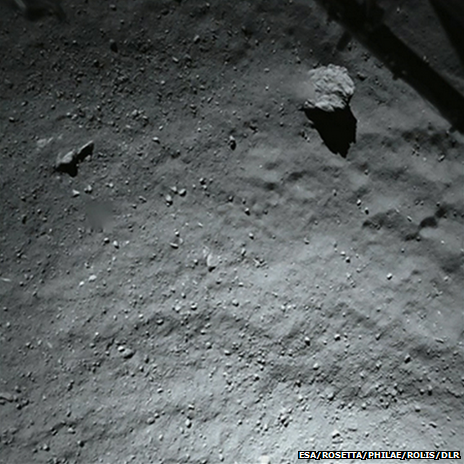
This picture was taken by the lander itself just 40m from its bumpy touchdown
Esa's Rosetta mission, with its piggybacked Philae lander, was launched in 2004.
The pair covered 6.4 billion km to reach Comet 67P out near the orbit of Jupiter.
Scientists hope the investigations at the giant "ice mountain" can provide fresh insights on the origins of the Solar System.
Comets are believed to hold materials that are largely unchanged since the formation of the planets 4.6 billion years ago.
One theory holds that comets were responsible for delivering water to the early Earth.
Another idea is that they could even have "seeded" our world with the chemistry needed to help kick-start biology.
Researchers say the data they have acquired through Rosetta's observations from orbit, and now from Philae's work on the surface, will re-write the textbooks.
- Published14 November 2014
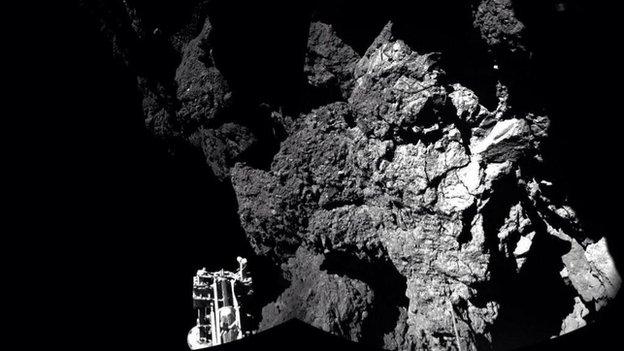
- Published14 November 2014

- Published13 November 2014
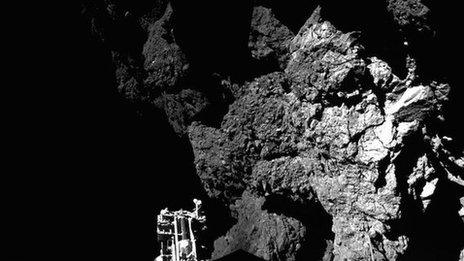
- Published13 November 2014
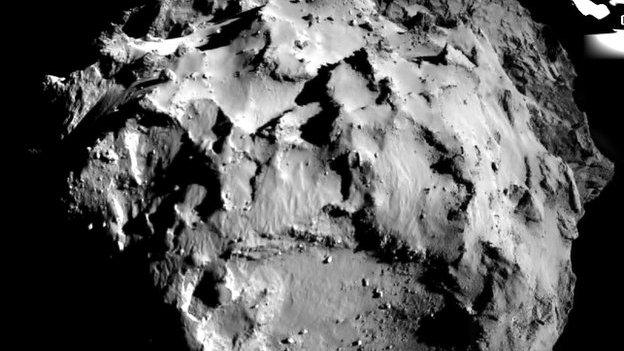
- Published13 November 2014
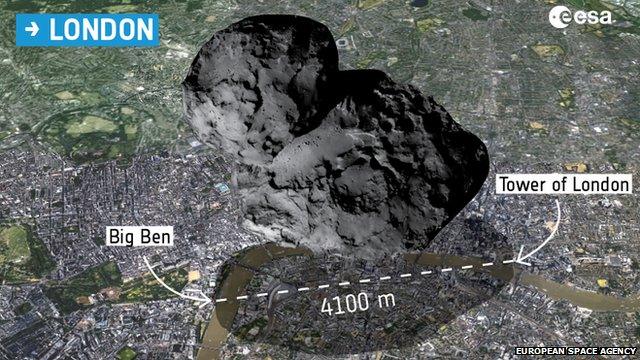
- Published13 November 2014
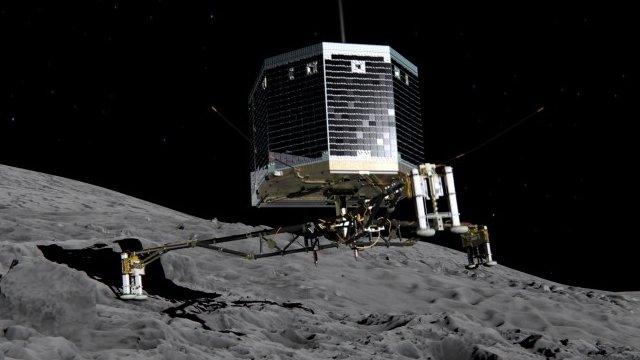
- Published13 November 2014
